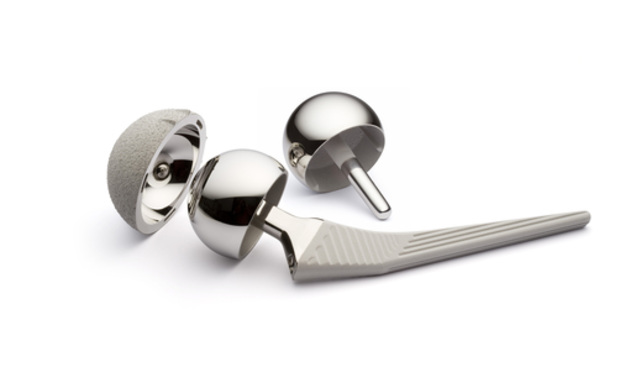Hip-Implant Defect Case Pre-empted After Third Circuit Defines 'Device'
A hip-implant device with component parts that were subject to different regulatory classifications should be pre-empted by federal law, the U.S. Court of Appeals for the Third Circuit has ruled in an issue of apparent first impression.
March 01, 2018 at 05:50 PM
4 minute read
 DePuy hip implant. Photo: Wikimedia
DePuy hip implant. Photo: Wikimedia A hip-implant device with component parts that were subject to different regulatory classifications should be pre-empted by federal law, the U.S. Court of Appeals for the Third Circuit has ruled in an issue of apparent first impression.
A three-judge panel ruled Thursday in Shuker v. Smith & Nephew that, when considering pre-emption issues, courts should look to the premarket approval classification for each individual component, rather than consider the multicomponent device as a whole. The ruling sided with hip implant maker Smith & Nephew as well as the U.S. Food and Drug Administration, which handles the premarket approval of medical devices.
The plaintiff, Walter Shuker, had argued that not treating the entire hybrid device he alleged was defective as a single device would produce “unfairness and incongruity” since one of the components had been used in an off-label manner.
However, Third Circuit Judge Cheryl Ann Krause said the statutory definition of device, the treatment of off-label uses, and FDA guidance all warranted an approach examining hybrid devices on a component level.
“The regulatory landscape contemplates that devices may be broken down into component parts and individual components used separately by third parties,” Krause said. “It is not surprising, then, that several courts have held that when a single component of a Class III device is used on its own, rather than in the premarket-approved system, express pre-emption adheres to the individual premarket-approved component.”
Shuker's case stemmed from a hip replacement that involved implanting a multicomponent device. Most of the components were Class II devices, but one of the components, which was referred to as an “R3 metal liner,” was a Class III device, which received a greater level of premarket approval scrutiny. Complicating matters was the fact that the R3 liner only received premarket approval to be used in the “Birmingham Hip Resurfacing System,” and the Class II components used in the rest of Shuker's hip implant were from a different system.
The use of the R3 system created a “metal-on-metal articulation,” Krause said, and eventually Shuker had to have a revision surgery.
Shuker sued and contended, among other things, that because the R3 liner had not been approved for use outside the Birmingham system the entire hybrid device constituted off-label use for which pre-emption would not apply.
Although Krause rejected that argument, her analysis did not end with whether the claims were pre-empted, and she eventually reversed the lower court's decision to dismiss some of Shuker's parallel claims.
Attorney Eric Zajac of Zajac & Arias, who is representing Shuker, said the panel appeared to be concerned with how the R3 liner was marketed, noting that, despite its name, the liner component had not been approved for use in the “R3 Acetabular System,” which is where the other components used in Shuker's hip replacement came from. The Third Circuit's ruling revived the negligence, loss of consortium and fraud claims premised on those marketing-related arguments.
“The analysis did not simply end [with pre-emption],” he said. “Pre-emption will not close the courthouse doors.”
Zajac & Arias attorney Robert Astrachan, who argued the case before the Third Circuit panel, also said district courts in New York, Connecticut and West Virginia have split on the first-impression issue, and the Third Circuit's ruling is the first statement by a federal appeals court about how to handle pre-emption for devices that have multiple components.
Sara Gourley of Sidley Austin, who argued the case for Smith & Nephew, did not return a call seeking comment.
This content has been archived. It is available through our partners, LexisNexis® and Bloomberg Law.
To view this content, please continue to their sites.
Not a Lexis Subscriber?
Subscribe Now
Not a Bloomberg Law Subscriber?
Subscribe Now
NOT FOR REPRINT
© 2025 ALM Global, LLC, All Rights Reserved. Request academic re-use from www.copyright.com. All other uses, submit a request to [email protected]. For more information visit Asset & Logo Licensing.
You Might Like
View All

Phila. Med Mal Lawyers In for Busy Year as Court Adjusts for Filing Boom
3 minute read
'Recover, Reflect, Retool and Retry': Lessons From Women Atop Pa. Legal Community
3 minute read
EDPA's New Chief Judge Plans to Advance Efforts to Combat Threats to Judiciary
3 minute readTrending Stories
- 1The Public-Private Dichotomy in State-Created Insurance Entities
- 2How I Made Practice Group Chair: 'It’s a Job About People, First and Foremost,' Says Alexander Lees of Milbank
- 3Morris Nichols Names New Chief Financial Officer
- 4People in the News—Jan. 24, 2025—Klehr Harrison, Willig Williams
- 5Best Practices for Conducting Workplace Investigations: A Legal and HR Perspective
Who Got The Work
J. Brugh Lower of Gibbons has entered an appearance for industrial equipment supplier Devco Corporation in a pending trademark infringement lawsuit. The suit, accusing the defendant of selling knock-off Graco products, was filed Dec. 18 in New Jersey District Court by Rivkin Radler on behalf of Graco Inc. and Graco Minnesota. The case, assigned to U.S. District Judge Zahid N. Quraishi, is 3:24-cv-11294, Graco Inc. et al v. Devco Corporation.
Who Got The Work
Rebecca Maller-Stein and Kent A. Yalowitz of Arnold & Porter Kaye Scholer have entered their appearances for Hanaco Venture Capital and its executives, Lior Prosor and David Frankel, in a pending securities lawsuit. The action, filed on Dec. 24 in New York Southern District Court by Zell, Aron & Co. on behalf of Goldeneye Advisors, accuses the defendants of negligently and fraudulently managing the plaintiff's $1 million investment. The case, assigned to U.S. District Judge Vernon S. Broderick, is 1:24-cv-09918, Goldeneye Advisors, LLC v. Hanaco Venture Capital, Ltd. et al.
Who Got The Work
Attorneys from A&O Shearman has stepped in as defense counsel for Toronto-Dominion Bank and other defendants in a pending securities class action. The suit, filed Dec. 11 in New York Southern District Court by Bleichmar Fonti & Auld, accuses the defendants of concealing the bank's 'pervasive' deficiencies in regards to its compliance with the Bank Secrecy Act and the quality of its anti-money laundering controls. The case, assigned to U.S. District Judge Arun Subramanian, is 1:24-cv-09445, Gonzalez v. The Toronto-Dominion Bank et al.
Who Got The Work
Crown Castle International, a Pennsylvania company providing shared communications infrastructure, has turned to Luke D. Wolf of Gordon Rees Scully Mansukhani to fend off a pending breach-of-contract lawsuit. The court action, filed Nov. 25 in Michigan Eastern District Court by Hooper Hathaway PC on behalf of The Town Residences LLC, accuses Crown Castle of failing to transfer approximately $30,000 in utility payments from T-Mobile in breach of a roof-top lease and assignment agreement. The case, assigned to U.S. District Judge Susan K. Declercq, is 2:24-cv-13131, The Town Residences LLC v. T-Mobile US, Inc. et al.
Who Got The Work
Wilfred P. Coronato and Daniel M. Schwartz of McCarter & English have stepped in as defense counsel to Electrolux Home Products Inc. in a pending product liability lawsuit. The court action, filed Nov. 26 in New York Eastern District Court by Poulos Lopiccolo PC and Nagel Rice LLP on behalf of David Stern, alleges that the defendant's refrigerators’ drawers and shelving repeatedly break and fall apart within months after purchase. The case, assigned to U.S. District Judge Joan M. Azrack, is 2:24-cv-08204, Stern v. Electrolux Home Products, Inc.
Featured Firms
Law Offices of Gary Martin Hays & Associates, P.C.
(470) 294-1674
Law Offices of Mark E. Salomone
(857) 444-6468
Smith & Hassler
(713) 739-1250





